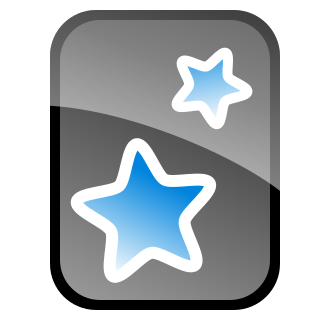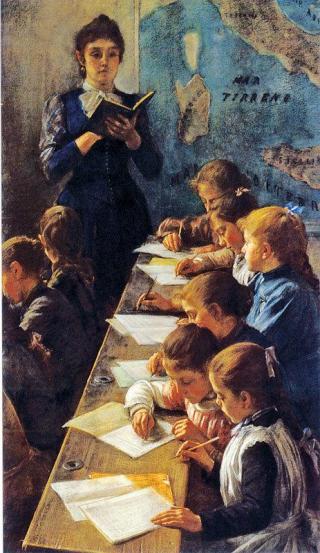
Incremental reading is a software-assisted method for learning and retaining information from reading, which involves the creation of flashcards out of electronic articles. "Incremental reading" means "reading in portions". Instead of a linear reading of articles one at a time, the method works by keeping a large list of electronic articles or books and reading parts of several articles in each session. The user prioritizes articles in the reading list. During reading, key points of articles are broken up into flashcards, which are then learned and reviewed over an extended period with the help of a spaced repetition algorithm.
Natural language processing (NLP) is an interdisciplinary subfield of computer science and linguistics. It is primarily concerned with giving computers the ability to support and manipulate speech. It involves processing natural language datasets, such as text corpora or speech corpora, using either rule-based or probabilistic machine learning approaches. The goal is a computer capable of "understanding" the contents of documents, including the contextual nuances of the language within them. The technology can then accurately extract information and insights contained in the documents as well as categorize and organize the documents themselves.
Readability is the ease with which a reader can understand a written text. In natural language, the readability of text depends on its content and its presentation. Researchers have used various factors to measure readability, such as:
A paraphrase is a restatement of the meaning of a text or passage using other words. The term itself is derived via Latin paraphrasis, from Ancient Greek παράφρασις (paráphrasis) 'additional manner of expression'. The act of paraphrasing is also called paraphrasis.

The Hong Kong Advanced Level Examination, or more commonly known as the A-level, conducted by the Hong Kong Examinations and Assessment Authority (HKEAA), was taken by senior students at the end of their matriculation in Hong Kong between 1979 and 2012. It was originally the entrance examination in University of Hong Kong until the introduction of the Joint University Programmes Admissions System (JUPAS) in 1992, which made it the major university entrance examination until academic year 2011/2012.
Reading comprehension is the ability to process written text, understand its meaning, and to integrate with what the reader already knows. Reading comprehension relies on two abilities that are connected to each other: word reading and language comprehension. Comprehension specifically is a "creative, multifaceted process" dependent upon four language skills: phonology, syntax, semantics, and pragmatics.
The N400 is a component of time-locked EEG signals known as event-related potentials (ERP). It is a negative-going deflection that peaks around 400 milliseconds post-stimulus onset, although it can extend from 250-500 ms, and is typically maximal over centro-parietal electrode sites. The N400 is part of the normal brain response to words and other meaningful stimuli, including visual and auditory words, sign language signs, pictures, faces, environmental sounds, and smells.
The Rotter Incomplete Sentences Blank is a projective psychological test developed by Julian B. Rotter. It comes in three forms and comprises 40 incomplete sentences usually only 1–2 words long, such as "I regret ..." and "Mostly girls ...". As with other sentence completion tests, the subject is asked to complete the sentence.
The Test of English Proficiency developed by Seoul National University or TEPS is an English proficiency test created by Seoul National University's Language Education Institute to evaluate South Korean test takers' English language skills. TEPS has been administered nationwide since January 1999. It consists of 200 questions which are divided into four sections: Listening, Grammar, Vocabulary, and Reading. TEPS scores are divided into the ten ratings ranging from 1 + to 5. It is designed to test applicants' communicative English skills and to minimize test-taker reliance on certain strategies such as rote memorization. A study of the test indicated that it is valid and fair.
The generation effect is a phenomenon where information is better remembered if it is generated from one's own mind rather than simply read. Researchers have struggled to account for why the generated information is better recalled than read information, but no single explanation has been sufficient.
The Connecticut Mastery Test, or CMT, is a test administered to students in grades 3 through 8. The CMT tests students in mathematics, reading comprehension, writing, and science. The other major standardized test administered to schoolchildren in Connecticut is the Connecticut Academic Performance Test, or CAPT, which is given in grade 10. Until the 2005–2006 school year, the CMT was administered in the fall; now it is given in the spring.
Language teaching, like other educational activities, may employ specialized vocabulary and word use. This list is a glossary for English language learning and teaching using the communicative approach.
The direct method of teaching, which is sometimes called the natural method, and is often used in teaching foreign languages, refrains from using the learners' native language and uses only the target language. It was established in England around 1900 and contrasts with the grammar–translation method and other traditional approaches, as well as with C.J. Dodson's bilingual method. It was adopted by key international language schools such as Berlitz, Alliance Française and Inlingua in the 1970s and many of the language departments of the Foreign Service Institute of the U.S. State Department in 2012.

Anki is a free and open-source flashcard program using spaced repetition, a technique from cognitive science for memorization. The name comes from the Japanese word for "memorization".

The Deutsches Sprachdiplom der Kultusministerkonferenz (engl.: German Language Certificate of the Education Ministers Conference) is an official German language certificate of the German education authorities and the Foreign Office (Germany) certifying levels of knowledge of the German language in schools worldwide. The program, originally intended to stimulate interest in German, has run since 1973 and, different from the equivalent certificates of the Goethe Institute, is meant for students at officially recognized schools abroad, either Diploma schools or German Schools Abroad. The program prepares the participants for a study in Germany in matters of language and cultural issues. It finishes with an exam and a certification on language competencies on level A2/B1 or B2/C1 of the Common European Framework of Reference for Languages. The certificate together with national school leaving examinations entitles foreign students to apply for university entry in Germany.

Tatoeba is a free collection of example sentences with translations geared towards foreign language learners. It is available in more than 400 languages. Its name comes from the Japanese phrase "tatoeba" (例えば), meaning "for example". It is written and maintained by a community of volunteers through a model of open collaboration. Individual contributors are known as Tatoebans. It is run by Association Tatoeba, a French non-profit organization funded through donations.

An examination or test is an educational assessment intended to measure a test-taker's knowledge, skill, aptitude, physical fitness, or classification in many other topics. A test may be administered verbally, on paper, on a computer, or in a predetermined area that requires a test taker to demonstrate or perform a set of skills.

Dictation is the transcription of spoken text: one person who is "dictating" speaks and another who is "taking dictation" writes down the words as they are spoken. Among speakers of several languages, dictation is used as a test of language skill, similar to spelling bees in the English-speaking world. Secondary to teaching language skills, the exercise of dictation has also been used to introduce students to literary works, and to instill morals.
The SAT Subject Test in Spanish was a standardized test given by the College Board that assessed fluency in Spanish among high school students. It was typically taken after three to four years of studying the language, once the student had reached a significant level of understanding and competence in it. The test also partially emphasized preparation for AP Spanish and/or Spanish as a course in College. Passage selections were drawn from prose fiction, historical works, and newspaper and magazine articles, as well as advertisements, flyers and letters.

Generative Pre-trained Transformer 1 (GPT-1) was the first of OpenAI's large language models following Google's invention of the transformer architecture in 2017. In 2018, OpenAI released a paper entitled "Improving Language Understanding by Generative Pre-Training", in which they introduced that initial model along with the general concept of a generative pre-trained transformer.







